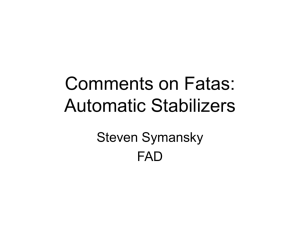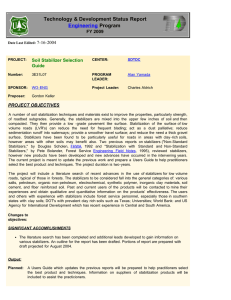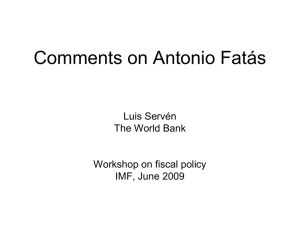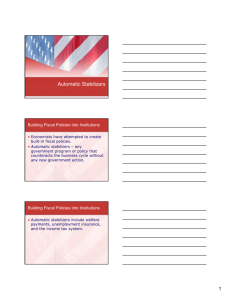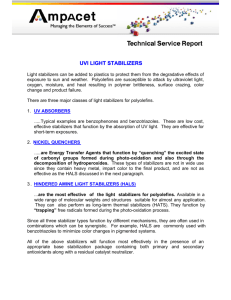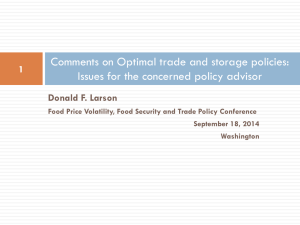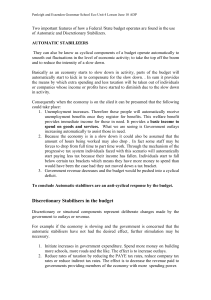Comments on Automatic Stabilizers
advertisement
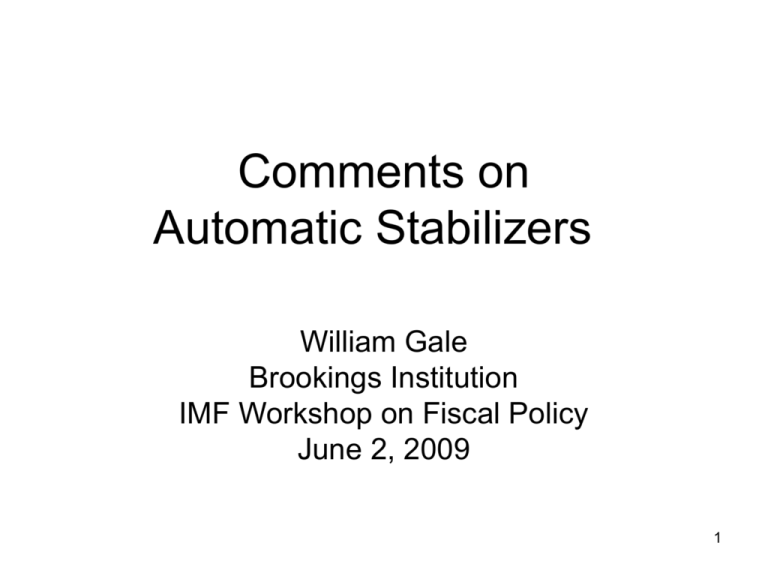
Comments on Automatic Stabilizers William Gale Brookings Institution IMF Workshop on Fiscal Policy June 2, 2009 1 Two Issues • Trade-offs between stabilization and efficiency • Trade-offs between stabilization and sustainability 2 Stabilization and Efficiency 3 “Pure” Keynesian Model • Automatic stabilizers work through aggregate demand. • All shocks are demand shocks. • In this framework, a more progressive tax system provides more “income insurance” against shocks and therefore is a better stabilizer. • This creates a trade-off between efficiency (which requires lower rates) and stabilization 4 Keynesian Model • “It takes a lot of Harberger triangles to fill an Okun gap.” – Captures the notion of a trade-off – Implies that in the Keynesian framework, the terms are tilted heavily toward stabilization policy, away from efficiency. 5 How strong is the AD channel? • Depends on the sensitivity of after-tax income to changes in pre-tax income… • …And on the sensitivity of consumption to temporary changes in after-tax income. – Standard models suggest temporary income tax cuts should generate a smaller response than a permanent one. • Empirical evidence is mixed, but the MPC out of temporary resources is clearly not zero. 6 Supply shocks • Supply shocks do exist. • We don’t want to stabilize output in response to a supply shock, we want to let output adjust. • But automatic stabilizers often still stabilize. 7 Automatic stabilizers also work through supply channels • …Regardless of whether the shock is to demand or supply • The policy commitment not to leave resources idle should spur investment in human and physical capital. (Positive effect on long-term efficiency) • More complete insurance against downturns can mute the private sector response and needed adjustments. (Negative effect on long-term efficiency) • Progressive taxes will affect labor supply, as well as consumption. – Note that a temporary income tax rate change should generate a stronger labor supply response than a permanent change. 8 Revised View of the Trade-off between Stabilization and Efficiency • If (a) the negative effects of automatic stabilizers on aggregate supply are sufficiently strong, and (b) initial tax rates are sufficiently high, there may not be a trade-off between efficiency and stabilization policy. • In practice, the evidence suggests that some OECD countries are in the relevant range. – But the evidence is not overwhelming 9 Stabilization and Sustainability 10 Spain • Long expansion fueled by housing and asset growth. • Substantial boost in revenues. How much is temporary, due to the changing composition of the economy, how much is permanent/ structural? • The majority is temporary/compositional. • Has important implications for understanding what is cyclical and what is structural. – The recent downturn shows the dangers of not making careful distinctions. 11 US Automatic Stabilizers • US has smaller automatic stabilizers than European countries • They operate almost exclusively through the tax side. • Auerbach/Feenberg and Cohen/Follette find that 8-10% of income fluctuations are offset by automatic stabilizers. 12 Trade-off between automatic stabilizers (rules) and discretionary fiscal policy • US has a larger discretionary fiscal package in the current downturn and significantly more fluid labor markets. • What’s the best combination of automatic and discretionary policy? 13 American Evidence on the Trade-off Between Stabilization and Efficiency • Kneiser and Ziliak, AER, 2002 • The tax reforms in the 1980s reduced MTRs significantly. • They measure the effects on labor supply, consumption volatility and utility. • PSID data 14 Kneiser and Ziliak, cont. • The tax cuts generate efficiency gains but stabilization losses. – The lower MTRs raised consumption volatility such that the average household would pay 2.5% of income to obtain the same consumption volatility under the post-1986 system as they had under the pre-1981 tax system. • Similar micro work in European context would be interesting. 15
